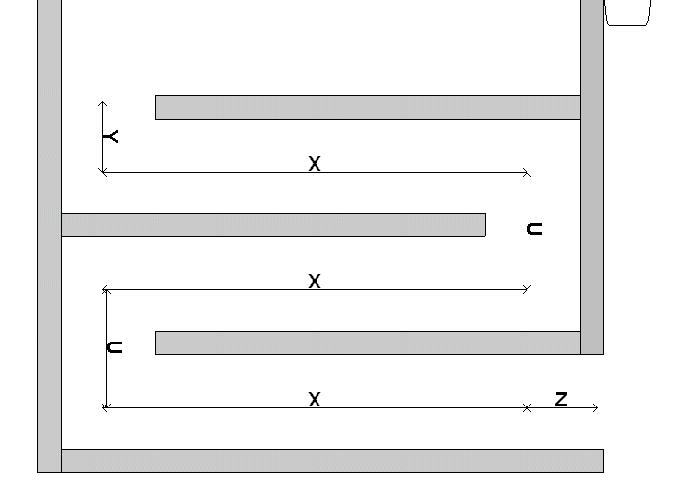The parameters for this speaker are:

| The Speaker Guy | ||||||||||||||||||||||||||||||||||||||||||||
| Dedicated to really cheap audio enthusiasts | ||||||||||||||||||||||||||||||||||||||||||||
| The Anatomy One was designed primarily with Abacus design software. I liked Abacus because it offered standardized alignments with the ability to compare to user-selected alignments. | ||||||||||||||||||||||||||||||||||||||||||||
| The driver is from Parts Express, model #269-469. This is a 4" paper cone with a cloth surround. The parameters for this speaker are: |
||||||||||||||||||||||||||||||||||||||||||||
| Frequency Response = 118Hz to 18kHz | ||||||||||||||||||||||||||||||||||||||||||||
| fS = 118Hz | ||||||||||||||||||||||||||||||||||||||||||||
| VAS = 0.11 cubic feet | ||||||||||||||||||||||||||||||||||||||||||||
| QTS = 0.59 | ||||||||||||||||||||||||||||||||||||||||||||
| According to the Abacus software, with Keele's alignment I get the following: | ||||||||||||||||||||||||||||||||||||||||||||
| VB =10.27 liters | ||||||||||||||||||||||||||||||||||||||||||||
| fB = 80.53Hz | ||||||||||||||||||||||||||||||||||||||||||||
| f3dB = 80.53Hz | ||||||||||||||||||||||||||||||||||||||||||||
| OK, 80Hz is pretty good for a little 4" driver, but 10.27 liters is about the size of two large shoeboxes put together. Because I wanted to use the Anatomy One speakers as high-grade computer speakers as opposed to low-grade stereo speakers, this was a bit bigger than I wanted. Also, I think I will make a subwoofer to go along with these. Therefore, because T-Rex class bass is not the objective, I chose a much smaller box volume of only 2.5 liters. | ||||||||||||||||||||||||||||||||||||||||||||
| Tuning the smaller than optimum enclosure involves making a compromise. The smaller enclosure creates significant peaking in the response just below 200Hz. Lowering the box tuning frequencies reduces the peaking, but the port length starts increasing rapidly just before you get the peaking under control. At this time I had to make two decisions. I left the peaking at about 2dB, and I decided to do a folded port within the box volume. If I chose a box width of 5" (12.7cm) and a folded port height of 1" (2.54cm), this corresponds to a round port of 2.52" (6.4cm). One of the default port diameters in Abacus is 2.5", so I am in business. | ||||||||||||||||||||||||||||||||||||||||||||
| Decreasing the tuning frequency of the 2.5 liter enclosure until I get about 2dB of peaking gives me a port length of 422mm, or 16.6". This corresponded to a box tuning frequency of 90Hz. Now it is math time. With a total length of the order of 16", I figure I will fold the port back and forth a total of three times, with roughly 5.3" length, plus the length of the turns. The equation for this is: | ||||||||||||||||||||||||||||||||||||||||||||
| Total Length = (3 * X) + (2 * Turn Around Length) + Entrance Length + Exit Length | ||||||||||||||||||||||||||||||||||||||||||||
| Where | ||||||||||||||||||||||||||||||||||||||||||||
| Total Length is the equivalent port length (16.6") | ||||||||||||||||||||||||||||||||||||||||||||
| X is the length of each of the three legs | ||||||||||||||||||||||||||||||||||||||||||||
| Turn Around Length (U) is the length of the two U-turns in the port (1") | ||||||||||||||||||||||||||||||||||||||||||||
| Entrance Length (Y) is the length into the port (0.5") | ||||||||||||||||||||||||||||||||||||||||||||
| Exit Length (Z) is the length out of the port (0.5") | ||||||||||||||||||||||||||||||||||||||||||||
| Substituting gives: | ||||||||||||||||||||||||||||||||||||||||||||
| 16.63 = (3 * X) + (2 * 1") + 0.5" + 0.5" | ||||||||||||||||||||||||||||||||||||||||||||
| or | ||||||||||||||||||||||||||||||||||||||||||||
| X = 4.53" | ||||||||||||||||||||||||||||||||||||||||||||
 |
||||||||||||||||||||||||||||||||||||||||||||
| The actual depth of my enclosure is 4.53" plus the 0.5" on either side, or 5.5". Then I took my box volume of 2.5 liters, and converted this to 152.65 cubic inches. Given my predetermined box width of 5", and my 5.5" result for the depth calculates out to a height of 5.54". Obviously these dimensions are nowhere near the golden ratio (what is the gold standard these days?), but a small voice said, "Trust your feelings". And I didn't feel like doing all the calculations again. | ||||||||||||||||||||||||||||||||||||||||||||
| I used Microsoft Works spreadsheet to do these calculations. If you don't know how to use a spreadsheet, learn. The built-in help functions are excellent. Along with all the excellent online, freeware, shareware and commercial software for speaker design this is one tool you want in your toolbox. | ||||||||||||||||||||||||||||||||||||||||||||
| Next I took the dimensions from the spreadsheet and turned to Visio 2000. Visio has been an excellent, easy to learn drawing program from its inception, and each version is getting better. I have used it for everything from flowcharts to designing my backyard sprinkler system. | ||||||||||||||||||||||||||||||||||||||||||||
| I started with the side view, and drew a box 5.5" wide by 5.5" tall. This box corresponds to the enclosed volume. I had already decided to use ¼" (6.35mm) acrylic plastic for the enclosure. I started surrounding the box with edge view pieces of sides, top bottom and the dividers for the internal port. Then I copied these to another page, and manipulated them into the front view. | ||||||||||||||||||||||||||||||||||||||||||||
| Once the front and the side views are done, spent a few moments to verify that all the pieces are of the correct dimension. That is, if the side view has the front piece overlapping the top, double check that it is the same way in the front view. When you are sure of your work, proceed to copy the drawings to a third page, which is the cut list. This shows all the pieces in full view (not edge view). Move the pieces around on the page until you have an approximately solid rectangle. This helps to organize the construction and buy the correct amount of material. | ||||||||||||||||||||||||||||||||||||||||||||
| At this point I had not added any dimensions for the speaker opening or the wire terminals on the rear. I probably should have, but it made no difference in the end (translation: I got lucky). | ||||||||||||||||||||||||||||||||||||||||||||
| Now it's out to the garage. | ||||||||||||||||||||||||||||||||||||||||||||